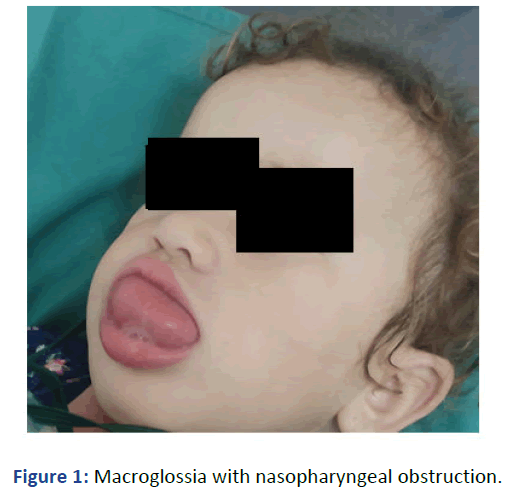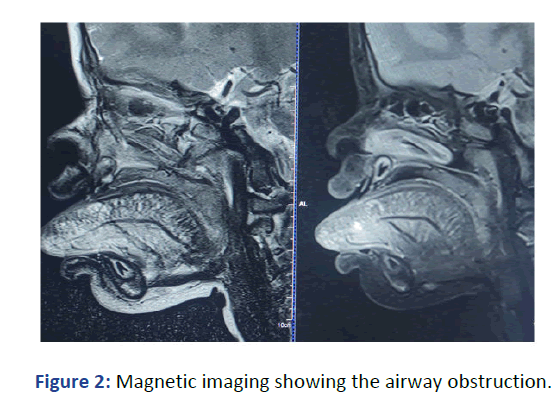Case Report - (2023) Volume 9, Issue 3
Airway Management of a Rare Case of Enormous Obstructive Macroglossia during Magnetic Imaging under Deep Sedation: A Pediatric Case Report
Anouar Jarraya1*,
Manel Kammoun1,
Kamel Kolsi1,
Yosr Hentati2,
Manar Hbaieb3 and
Manel Belhadj Mansour3
1Department of Pediatric Anesthesiology and Critical Care, University of Sfax, Sfax, Tunisia
2Department of Radiology, University of Sfax, Sfax, Tunisia
3Department of Pediatric Surgery, University of Sfax, Sfax, Tunisia
*Correspondence:
Anouar Jarraya, Department of Pediatric Anesthesiology and Critical Care, University of Sfax, Sfax,
Tunisia,
Email:
Received: 28-Oct-2022, Manuscript No. IPJICC-23-14607;
Editor assigned: 02-Nov-2022, Pre QC No. IPJICC-23-14607 (PQ);
Reviewed: 16-Nov-2022, QC No. IPJICC-23-14607;
Revised: 22-May-2023, Manuscript No. IPJICC-23-14607 (R);
Published:
20-Jun-2023, DOI: 10.35248/2471-8505.9.3.021
Abstract
The airway management of pediatric patients with facial dysmorphia can be difficult and can be associated with high anesthesia-related morbidity. In this case report, we describe the management of a rare case of enormous macroglossia causing nasopharyngeal obstruction among a 3-year-old girl with no comorbidities scheduled for Magnetic Resonance Imaging (MRI) of the face, requiring deep sedation to maintain the child immobile during the MRI procedure. This case study demonstrates how sedation in lateral position enabled the anesthesia challenge to be won. It allowed improved anesthetic outcomes by reducing the risk of difficult airway and aspiration.
Keywords
Airway; Deep sedation; Magnetic imaging; Macroglossia; Lateral position
Introduction
It was predicted that macroglossia might cause difficult
perioperative airway management [1]. Preparations for
difficult airways should always be considered. Magnetic
imaging is often needed before surgery. In pediatric patients,
deep sedation to maintain the child immobile during the MRI
procedure is always required [2]. However, anesthesia outside
the operating room for patients with difficult airways is highly
risky. We report an original airway management that allowed
the success of the procedure without any anesthesia-related
morbidity [3].
Case Presentation
Patient Information
A 3-year-old girl presented to the pediatric anesthesiology
department with congenital enlargement of the tongue
(Figure 1). The patient had progressive difficulty ingesting
solid food and suffered from obstructive sleep apnea and
snoring. The mother reported recurrent upper respiratory
tract infections the last year. However, the patient had normal
physical, functional and motor development. The patient had
no past history of anesthesia or surgery and we had no
available genetic screening for this patient [4].

Figure 1: Macroglossia with nasopharyngeal obstruction.
Clinical Findings
In the anesthesia preoperative assessment, the patient had
correct general conditions. She had also no abnormal cardiac
or breathing sounds. The risk of difficult intubation was
identified as she presents with macroglossia, limited mouth
opening and facial dysmorphia. The use of a laryngeal mask or
I-Gel seems to be impossible. Moreover, the risk of aspiration
during anesthesia was evoked as the patient had drooling and
difficulty in swallowing [5].
Timeline of current episode: Since childbirth, the patient's
tongue had enlarged gradually. Swallowing and breathing
have become more difficult in the last three months. The
patient was referred from the maxillofacial department to
have a preoperative MRI under general anesthesia. She will
be scheduled for surgical tongue reduction.
Diagnostic assessment: A cystic lymphangioma of the tongue
was suspected in front of this macroglossia. The MRI of the
face showed a capillary lymphatic venous malformation of the
right tongue that extended towards the floor of the mouth
(Figure 2) [6].

Figure 2: Magnetic imaging showing the airway obstruction.
Therapeutic interventions: Oral midazolam 0.5 mg/kg was
given to the patient 20 minutes before the MRI. All the
preparations for the anticipated difficult intubation/
ventilation and tracheostomy were kept ready. The anesthesia
induction was done with a 6% sevoflurane induction after
correct pre-oxygenation. Monitoring was initiated with
continuous ECG, oxygen saturation, temperature and noninvasive
blood pressure monitoring. Then, we inserted a 20 G
peripheral venous cannula. After anesthesia induction in a
supine position, the patient presented with oxygen
desaturation of 92% treated by mouth suctioning, high
oxygen flow and left lateral positioning. Anesthesia was
maintained by 1 MAC sevoflurane administered with a nasal
cannula with 2 L/min, 100% oxygen gas flow in lateral
positioning, well tolerated by the patient. The MRI procedure
lasted 24 min with no adverse effects. The patient was
breathing spontaneously and we noted no need for advanced
oxygen support or intubation. At the end of the procedure,
sevoflurane was stopped and the patient was maintained in a
lateral position with the administration of a nasal 2 L/min
100% O2 flow [7].
Follow-up and outcome of interventions: After the
anesthesia procedure, the patient was awaken in lateral
position and stayed for 2 hours in the post anesthesia care
unit. The evolution was favorable with no hemodynamic or
respiratory adverse events. The ambulatory procedure was
successful and the patient left the hospital the same day.
Patient perspective: the parents of the child were very
satisfied with the quality of healthcare.
Informed consent: Informed consent to publication was
obtained from the mother [8].
Results and Discussion
In this case report, we showed the interest and safety of
lateral position in children with difficult airways undergoing
deep sedation for a MRI procedure. This position has been
used previously for upper gastrointestinal endoscopy in
children to reduce the risk of aspiration. In our case report,
lateral positioning allowed the management of the risk of
difficult ventilation and reduced the risk of aspiration [9]. It
was reported that the upper airway of a sedated,
spontaneously breathing child widens in the lateral position.
The region between the tip of the epiglottis and the vocal
cords demonstrates the greatest relative percent increase in
size. For this reason we opted for lateral position in our
patient suffering from airway obstruction. However, in the
literature, lateral positioning was never used to manage
enormous macroglossia, leading to nasopharyngeal
obstruction and this was the originality of our case report
[10]. The most common form of respiratory obstruction
during pediatric deep sedation is the falling back of the
tongue into the pharynx, owing to the relaxation of the
muscular support. In our case, the risk of the fall of the
tongue when sedated in a supine position can be favored by
the increased weight of the tongue. In fact, there are several
instruments to overcome this difficulty, like the Guedel cannula, LMA Airways or I-Gel. Unfortunately, it was
impossible to insert these instruments into the mouth of our
patient as the macroglossia was obstructive. Furthermore, in
deeply sedated children, laryngeal devices did not protect the
airways from aspiration, particularly in our patient who had
drooling. Moreover, brutal insertion of these devices can lead
to ischemia of the oral and pharyngeal mucosa. In sedated
children, there is always a risk of apnea requiring ventilation
initially or intubation in the case of difficult ventilation [11].
Conclusion
In our case, the intubation will be difficult and require
particular skills and special devices. Nevertheless, difficult
intubation can have serious adverse effects. This case report
shows the utility of lateral positioning in deeply sedated
children with obstructive macroglossia. It allows better
anesthetic outcomes by reducing the risk of aspiration and
widening the upper airway, which may help in avoiding
difficult ventilation and intubation.
Competing Interest
The authors declare no competing interest.
Authors’ Contributions
Manel Kammoun: Article writing
Anouar Jarraya: Article revision
Yosr Hentati: Provided figures
Manar Hbaieb and Manel Belhadj Mansour: Data collection
Kamel Kolsi: Supervising
References
- Tsukamoto M, Hitosugi T, Yokoyama T (2016) Perioperative airway management of a patient with Beckwith-Wiedemann syndrome. J Dent Anesth Pain Med. 16(4):313-316.
[Crossref] [Google Scholar] [PubMed]
- Tewari A, Munjal M, Kamakshi, Garg S, Sood D, et al. (2007) Anaesthetic consideration in macroglossia due to lymphangioma of tongue: A case report. Indian J Anaesth. 53(1):79-83.
[Crossref] [Google Scholar] [PubMed]
- Bouchut JC, Godard J, Lachaux A, Diot N (2001) Deep sedation for upper gastrointestinal endoscopy in children. J Pediatr Gastroenterol Nutr. 32(1):108.
[Crossref] [Google Scholar] [PubMed]
- Oh SH (2018) sedation in pediatric esophagogastroduodenoscopy. Clin Endosc. 51(2):120-128.
[Crossref] [Google Scholar] [PubMed]
- Litman RS, Wake N, Chan LM, McDonough JM, Sin S, et al. (2005) Effect of lateral positioning on upper airway size and morphology in sedated children. Anesthesiology. 103(3):484-488.
[Crossref] [Google Scholar] [PubMed]
- Sheta SA (2010) Procedural sedation analgesia. Saudi J Anaesth. 4(1):11-16.
[Crossref] [Google Scholar] [PubMed]
- Ayedi M, Zouari J, Smaoui M, Jarraya A, Bouaziz I, et al. (2011) The performance of the i-gel® in comparison with the laryngeal mask airway classic: 19AP4-4. Eur J Anaesthesiol. 28:233.
[Google Scholar]
- Jarraya A, Elleuch S, Zouari J, Smaoui M, Laabidi S, et al. (2016) Postoperative analgesia in children when using clonidine in addition to fentanyl with bupivacaine given caudally. Pan Afr Med J. 24:182.
[Crossref] [Google Scholar] [PubMed]
- Kim YH (2012) Pulmonary aspiration associated with supraglottic airways: Proseal laryngeal mask airway and I-Gel™. Korean J Anesthesiol. 63(6):489-490.
[Google Scholar]
- Beylacq L, Bordes M, Semjen F, Cros AM (2009) The I‐gel®, a single‐use supraglottic airway device with a non‐inflatable cuff and an esophageal vent: An observational study in children. Acta Anaesthesiol Scand. 53(3):376-379.
[Crossref] [Google Scholar] [PubMed]
- Sequera-Ramos L, Duffy KA, Fiadjoe JE, Garcia-Marcinkiewicz AG, Zhang B, et al. (2021) The prevalence of difficult airway in children with Beckwith-Wiedemann syndrome: A retrospective cohort study. Anesth Analg. 133(6):1559-1567.
[Crossref] [Google Scholar] [PubMed]
Citation: Jarraya A, Kammoun M, Hentati Y, Hbaieb M, Mansour MB, et al. (2023) Airway Management of a Rare Case of Enormous Obstructive Macroglossia during Magnetic Imaging under Deep Sedation: A Pediatric Case Report. J Intensive Crit Care. 9:22.
Copyright: © 2023 Jarraya A, et al. This is an open-access article distributed under the terms of the Creative Commons Attribution License, which permits unrestricted use, distribution, and reproduction in any medium, provided the original author and source are credited.



